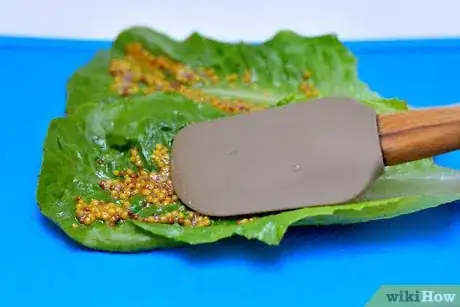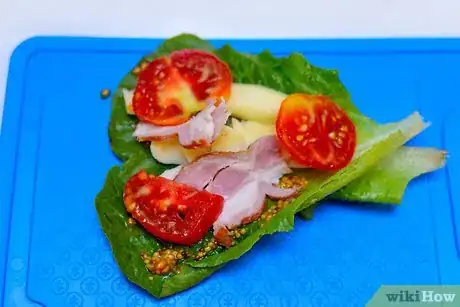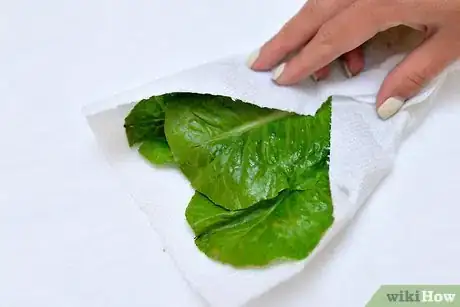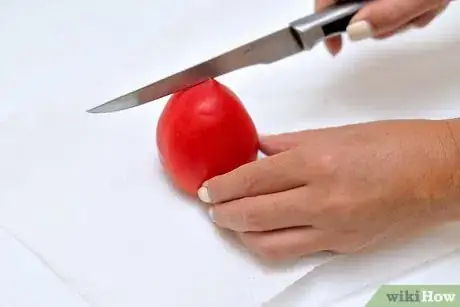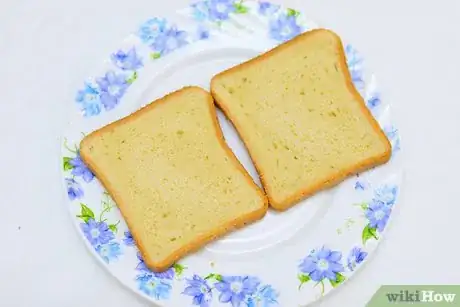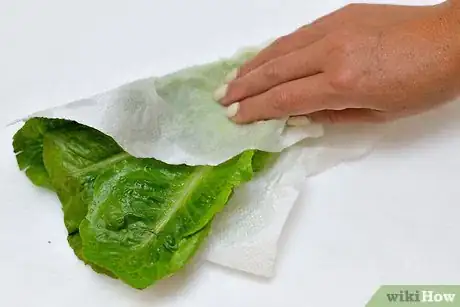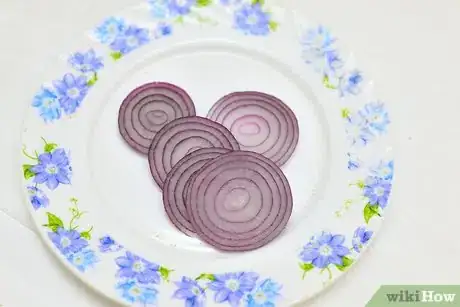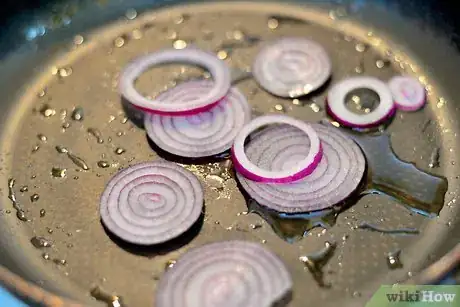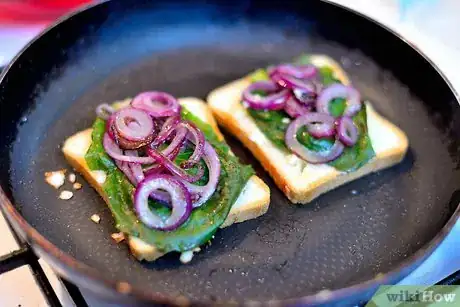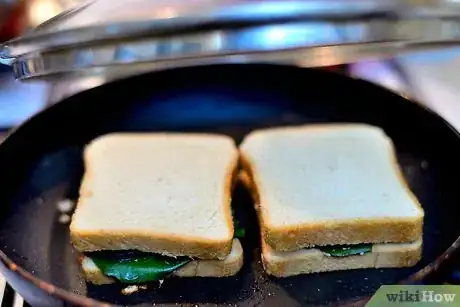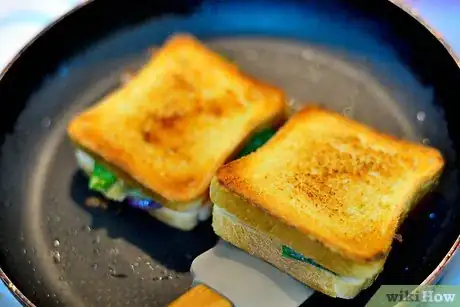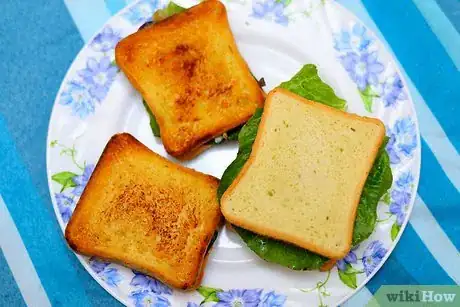This article was co-authored by wikiHow Staff. Our trained team of editors and researchers validate articles for accuracy and comprehensiveness. wikiHow's Content Management Team carefully monitors the work from our editorial staff to ensure that each article is backed by trusted research and meets our high quality standards.
There are 8 references cited in this article, which can be found at the bottom of the page.
This article has been viewed 22,531 times.
Learn more...
Kale is a great source of potassium, fiber, and antioxidants, and it has grown in popularity over the years because of the nutrients it offers.[1] While many people add it to smoothies or salads, you can also add it to that lunchtime staple: the sandwich. Add baby kale for a raw, tasty crunch, use it in place of bread, or even add it to a grilled cheese sandwich!
Ingredients
- 1 handful of raw baby kale
- 2 pieces of bread
- 3 slices of tomato
- 1 slice of deli cheese
- 3-4 slices of deli meat
- Mustard, mayonnaise, or other condiments to taste
Makes 1 sandwich
- 4 medium kale leaves
- 2 teaspoons (9.9 mL) of cooking oil
- 2 medium red onions
- 8 slices of bread
- Cooking spray
- Salt and pepper to taste
- 1 cup (240 mL) of shredded cheese(s)
Makes 4 sandwiches
Steps
Adding Kale to Your Favorite Sandwich
-
1Top your favorite sandwich with baby kale. Rinse the kale and pat it dry with a paper towel, and then use it as a topping. You can substitute it for lettuce or sprouts, or use it in addition to other toppings. Baby kale is soft enough that it doesn't need to be cooked down before you eat it.[2]
- You can even add kale to a peanut butter and jelly sandwich for some extra fiber without changing the flavor of the sandwich too much. Just put a thin layer in between the peanut butter and jelly.
-
2Add cooked kale for a tasty, nutritious topping. Curly kale is a little too tough to eat without first removing the stem and cooking it down a little bit. Trim off the stem from each leaf and add it to a hot pan with some olive oil, salt, and pepper. Sauté the kale for 4-5 minutes until it starts to wilt. Remove it from the heat and let it cool down before adding it to your sandwich.[3]
- You can store extra cooked kale in your fridge in an air-tight container for 1 week.
Advertisement -
3Wrap your sandwich in kale instead of using bread. Rinse and pat dry 1 or 2 large kale leaves and lay them flat on a plate. Place your toppings on the kale (meat, cheese, veggies, spreads, or whatever else you like in a sandwich). Roll the leaf up into a wrap, and then cut it in half to make it easier to handle.[4]
- A cup of kale has 33 calories in it—much less that even 1 piece of bread! Plus, if you're gluten-free or vegan, a kale wrap lets you still enjoy a sandwich.
Constructing a Basic Sandwich with Baby Kale
-
1Rinse your handful of kale and the uncut tomato and pat them dry. Turn on the kitchen sink to a cool temperature and quickly run the water over the fresh produce. Use a paper towel or clean dish towel to pat the produce dry. Set the kale to the side.[5]
- If you have a salad spinner, you can put the kale in there rather than patting it dry.
- Rinse the produce even if the bagging says it has already been cleaned—germs and dirt can get onto cleaned produce during the shipping and stocking process.
-
2Cut several 1⁄2 inch (1.3 cm) thick slices of tomato. Use a sharp kitchen knife and cutting board. Cutting thicker slices of tomato to keep it from falling apart on your sandwich. You can always use more or less tomato, depending on your preference.[6]
- Store the rest of the tomato in a plastic bag in the fridge for up to 1 week.
- If you don't like tomato, you can substitute lots of other veggies, like cucumber, avocado, peppers, or even sliced onion. Or feel free to add as much variety to your sandwich as you like!
-
3Set your 2 slices of bread on a plate to construct your sandwich. You can really get creative here—you could toast your bread before constructing your sandwich; you could use a bagel instead of bread; you could even use homemade bread.
- Store bread in an airtight container either on the counter, in a cupboard, or in the fridge to keep it fresh for longer. Never leave bread exposed to the air for long without covering it.
-
4Place your cheese and deli meat onto 1 slice of the bread. Put the slice of cheese against the bread and put the meat on top of that. The moisture from the deli meat could seep into the bread and make it soggy, so putting the cheese on first keeps that from happening.[7]
- If you can't eat or don't like cheese or meat, there are plenty of other options for you to choose from to construct your sandwich! Consider adding hummus, grilled veggies, tuna salad, or falafel. The options are endless!
-
5Add your tomato slices and then the rinsed kale on top of the meat. Arrange the produce so there is an even layer over the entire sandwich, rather than stacking all the toppings in the middle. Don't be afraid to really pile the kale on here—it compresses easily so you can add a lot and still hold the sandwich easily.[8]
- Making the kale the top layer protects the bread from getting soggy from the tomatoes.
-
6Apply your condiments and add the second piece of bread. You can always go condiment free, but if you like a little extra flavor, spread or drizzle your sandwich with mayo, mustard, ketchup, hot sauce, or any other condiment you like.[9]
- Don't forget about pickles, olives, and sun-dried tomatoes! These toppings can add a lot of flavor to a simple sandwich.
Making a Kale Grilled Cheese Sandwich
-
1Rinse the kale and remove the stems. After running cool water over the kale to wash off dirt and debris, pat it dry and move it to your cutting board. Using a sharp kitchen knife, cut alongside the thick stem on either side of the leaf. Discard of the stems and put the kale leaves to the side.[10]
- Instead of discarding the stems, you could set them aside to make a vegetable stock with other veggie trimmings later.
-
2Cut your onions into 1⁄2 inch (1.3 cm) slices. Put the onion onto your cutting board and peel off the outer layer. Then slice the onion in half lengthwise. Cut off the stem (or the “hairy” part of the onion). Cut the onion across the grain until you reach the root end. Set the sliced onion to the side.[11]
- Chew gum while cutting onions to prevent teary eyes. Or freeze the onions for 10-15 minutes before you cut them.
-
3Boil a pot of water, add the kale, then remove the pot from the heat for 4 minutes. You'll notice the kale turns a bright green color. This process helps soften the kale so when you bite into your sandwich you can easily tear it with your teeth.[12]
-
4Drain off the excess hot water and rinse the kale under cold water. When you're done, it should no longer be warm to the touch. Use a paper towel or clean dish towel to dry the leaves, and then set them to the side.[13]
- Because kale is such a hardy leaf, blanching it makes it a lot softer without compromising any of the nutrients.
-
5Add 2 tsp (9.9 mL) of cooking oil to a skillet over medium high heat. Tilt the skillet in different directions to coat the bottom evenly with the oil. You can test if the oil is hot by dripping a few drops of water into the pan—if it sizzles, it is hot![14]
- Use whatever kind of cooking oil you prefer: olive oil, canola oil, avocado oil, or even grape seed oil are all viable options.
-
6Put the onion into the hot skillet and sauté for 10 minutes, stirring often. Add salt and pepper if you like some extra seasonings with your onions. You'll know they are done when they are slightly browned and soft. Stir the onions frequently during the 10 minutes to help the heat distribute evenly. Remove the skillet from the heat once the onions are cooked.[15]
- Depending on the size of your skillet (using a small one versus a large one), you may need to cook the onions for longer. Just keep an eye on the cooking progress and continue cooking them until they are all soft and brown.
-
7Spray 1 side of each slice of bread with cooking spray. You can either place the bread down on a cutting board or on the counter. Lightly spray the bread, just enough to coat it without drenching it or making it soggy. If you don't like to use cooking spray, you can always use butter or a butter substitute for this process.[16]
- Don't forget to wipe down your counter after you finish cooking to clean up the excess cooking spray.
-
8Pu 4 slices of bread oiled-side down in a skillet and add cheese. Set the burner to medium-low heat. Sprinkle 1⁄4 cup (59 mL) of cheese on 4 slices of bread. Some cheeses that shred and melt well are cheddar, gouda, provolone and mozzarella, but use whatever cheese you prefer! There are even non-dairy cheese options you can purchase at the grocery store. [17]
- You can add more cheese or multiple kinds of cheeses for variety.
-
9Stack the kale, sautéed onions, and top piece of bread on the cheese. Use a spatula to press down on the sandwich to push the ingredients together. Don't worry if the sandwich appears to be really large. The heat from the skillet will help shrink the sandwich as it continues to cook.[18]
- The cheese on the bottom and the onion mixture on the top will help the toppings adhere to the bread.
-
10Put the lid on the skillet and cook for 5-7 minutes, flipping the sandwiches once. Check the sandwiches after the first 3 minutes and flip them over so both sides cook evenly. Put the lid back on and continue cooking for another 2-4 minutes, or until the cheese has melted and the sandwich has melded together.[19]
- The steam in the pan helps melt the cheese, so if you don't have a lid for the skillet try placing aluminum foil overtop to create the same effect.
-
11Remove the sandwiches from the heat and serve them! You could cut the sandwiches in half, pair it with a simple salad, or simply eat it on its own. This is a great way to get some kale into your sandwich without sacrificing on flavor.
- Wrap leftover sandwiches in aluminum foil and store in the fridge for 1-2 days. The bread will get soggy from the onions, so reheat it directly in the oven at 300 °F (149 °C) for 10 minutes. This will help to crisp the bread back up.
-
12Finished.
Things You'll Need
- Cutting board
- Sharp kitchen knife
- Paper towels or clean dish towel
- Small pot
- 2 skillets (at least 1 with a lid)
- Spatula
References
- ↑ https://www.medicalnewstoday.com/articles/270435.php
- ↑ https://keeperofthehome.org/5-ways-eat-kale-likely-havent-thought/
- ↑ https://www.thespruceeats.com/use-more-kale-in-sandwich-recipes-2937602
- ↑ http://www.eatingwell.com/recipe/255768/kale-turkey-wraps/
- ↑ https://foodrevolution.org/blog/how-to-wash-vegetables-fruits/
- ↑ https://www.foodnetwork.com/recipes/articles/5-sandwich-making-tips
- ↑ https://www.foodnetwork.com/recipes/articles/5-sandwich-making-tips
- ↑ https://www.foodnetwork.com/recipes/articles/5-sandwich-making-tips
- ↑ https://www.foodnetwork.com/recipes/articles/5-sandwich-making-tips
- ↑ https://foodrevolution.org/blog/how-to-wash-vegetables-fruits/
- ↑ https://www.thankyourbody.com/how-to-cut-an-onion/
- ↑ http://www.myrecipes.com/recipe/kale-onion-grilled-cheese
- ↑ http://www.myrecipes.com/recipe/kale-onion-grilled-cheese
- ↑ http://www.myrecipes.com/recipe/kale-onion-grilled-cheese
- ↑ http://www.myrecipes.com/recipe/kale-onion-grilled-cheese
- ↑ http://www.myrecipes.com/recipe/kale-onion-grilled-cheese
- ↑ http://www.myrecipes.com/recipe/kale-onion-grilled-cheese
- ↑ http://www.myrecipes.com/recipe/kale-onion-grilled-cheese
- ↑ http://www.myrecipes.com/recipe/kale-onion-grilled-cheese
